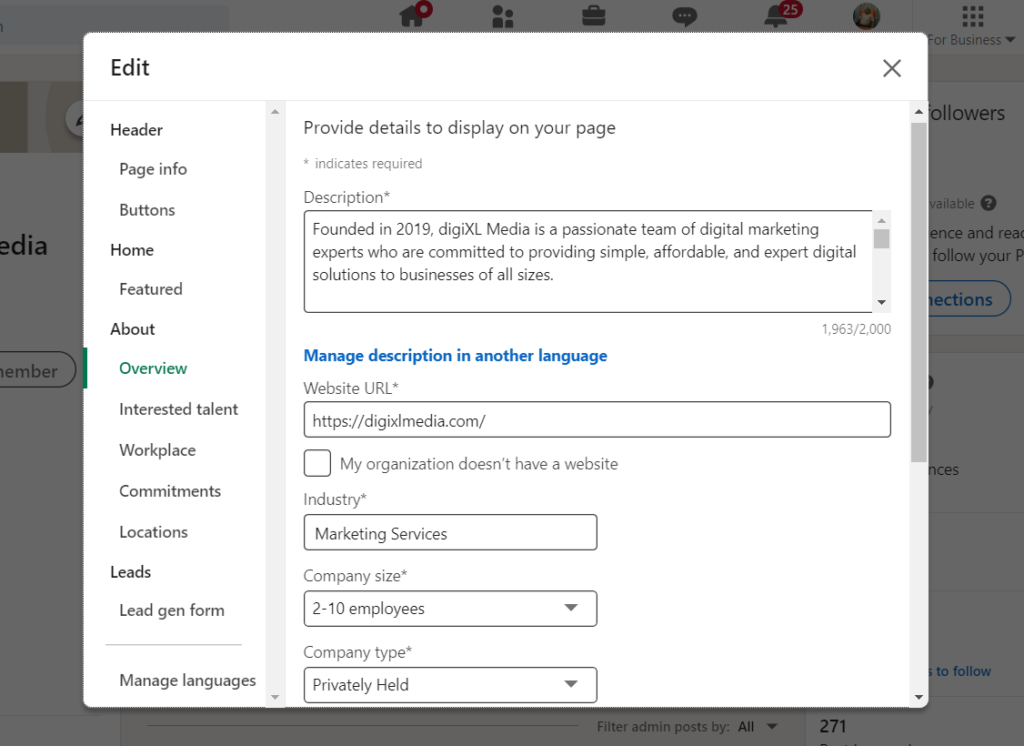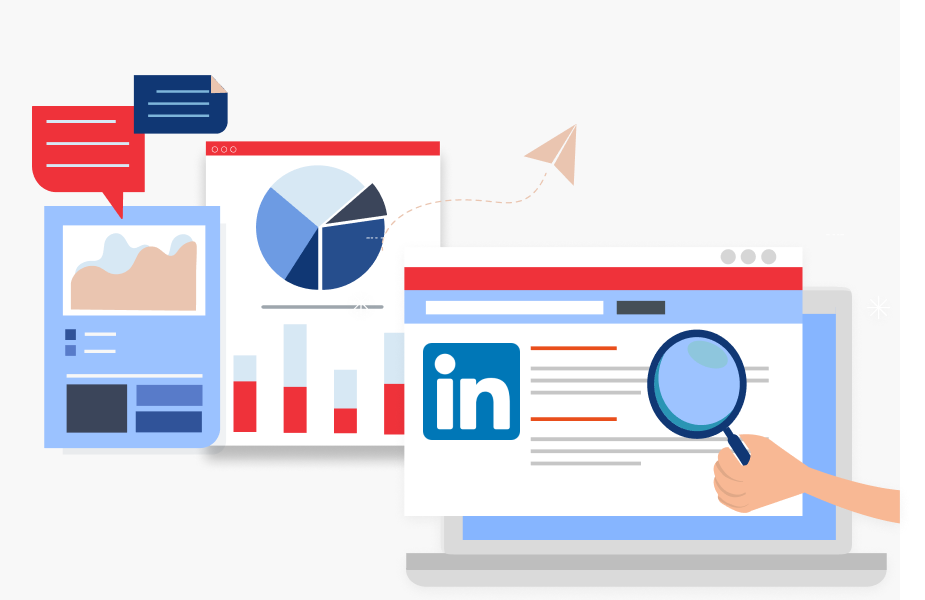LinkedIn, the professional networking giant, offers a unique opportunity to connect with potential clients, establish your brand as an industry leader, and ultimately make it a success.
But how do you navigate this professional landscape and turn connections into real success?
Our comprehensive guide will equip you with the knowledge to leverage LinkedIn for business, transforming it from a static profile into a dynamic tool for enhancing your brand and achieving your B2B goals.
How Can I Use LinkedIn for Business?
LinkedIn is like a giant online office party, but it’s more about how you can connect with the company professionals instead of focusing solely on the chips and punch!
You need a LinkedIn business page if you want your business to have its cool corner at this party. Let us learn how you can create a LinkedIn account for business:
Step 1: Setting Up Your LinkedIn Company Page
At first, you’ll need to have an individual account on LinkedIn, which will serve as the primary administrator for your Company Page.
As you move forward, additional managers can be added. Registering using your professional email address to align with your business identity is advisable.
Once you’re logged into your regular LinkedIn account, look up top right for a little icon that says “For Business.” Click on that, and a menu will pop up.
At the bottom, you’ll see an option to “Create a Company Page.”
After clicking on the option, “Create a Company Page”. Now let us select the type of Page that best fits your organization from the four options available such as:
- Company: Small, medium and large businesses
- Showcase Page: Sub-pages associated with existing pages
- Educational Institution: Schools and universities
Except for “Showcase pages,” which might be a bit confusing, the other options are pretty straightforward. Showcase pages are handy if you have different parts of your business that you want to highlight separately, but still connect them to your main company page.
You’ll notice Showcase Pages listed on your main Company Page. For example, Adobe decided to create separate pages for its different products like Creative Cloud, Commerce, Workfront, and Frame.io because they have different types of users.
Adobe is famous for making software like Photoshop, so their pages look good. The Showcase Pages have lots of helpful tips, event invites, and inspiring stuff.
Once you’ve chosen the type of Page you need, start filling in the details. Your logo and tagline are super important because they’re often the first things people notice about your Page. Take your time to come up with a catchy tagline that represents your business well.
For example, Adobe’s tagline is: “Changing the world through digital experiences”
When you’re finished, just click on “Create page” to get started.
Step 2: Optimizing Your LinkedIn Page
After you’ve got the basics right, now it’s time to make your Page even better so that more people can find you and follow you.

Start by scrolling down and clicking on the blue “Edit Page” button. Then, fill out all the fields in the extra information section.
This will help users understand what you do and improve your chances of showing up in search results on LinkedIn.
It is worth the effort because companies with complete profiles get 30% more views.
Step 3: Building Your Network Strategically
- Targeted Search
Use LinkedIn’s search bar to find potential clients, partners, and top talent. Filter your search by industry, job title, company size, or even keywords to reach the exact audience you’re looking for.
- Connect with Purpose
Instead of focusing on generic connections, make use of personalized messages. Mention a shared connection, reference something specific from their profile, or highlight why you think they would be a valuable connection.
- Join Relevant Groups
Groups are a good way to connect with like-minded professionals. Look for groups relevant to your industry and actively participate in discussions. Share your expertise, answer questions, and build meaningful connections.
Step 4: Making Your Profile Interactive
- Regular Posts
Share updates, articles, or interesting industry news and trends from your profile. You can make use of the Repost button as well. If you find an article interesting you can share it with your thoughts.
You can also create a social media calendar and post accordingly. For instance: if it’s Halloween, there can be a designated post based on the occasion which may include innovative captions and visuals to attract the audience.
- Respond to Comments
Don’t just post and disappear. Be active and be sure to answer questions and join conversations. It’s like chatting with potential customers who stop by your window.
- Keywords
Use relevant keywords in your description and posts so people searching for your industry can find you easily. Think of them like search terms people might use to find your shop on a map.
Step 5: Encouraging Employees to Update their LinkedIn Profiles
Asking the employees to update their LinkedIn profiles and share valuable posts from their accounts can have numerous benefits for both the individual and the organization.
Here’s why it’s important:
- Enhanced Professional Branding
LinkedIn is often the first place people look when researching a company or its employees. By having updated profiles, employees present themselves as engaged professionals who take pride in their work and stay current in their fields. This contributes to a positive image for both the individual and the company.
- Networking Opportunities:
LinkedIn is a powerful networking platform where professionals connect with peers, industry leaders, and potential collaborators. When employees keep their profiles up to date, they increase their visibility and are more likely to attract meaningful connections.
- Employee Advocacy:
Employees who actively engage on LinkedIn by sharing company updates, industry insights, or thought leadership content can significantly amplify the company’s reach and brand awareness.
When employees update their profiles regularly, they are more likely to participate in such advocacy efforts, thereby extending the company’s online presence and influence.
- Professional Development:
Updating LinkedIn profiles prompts employees to reflect on their skills, experiences, and accomplishments. This self-assessment can be a valuable exercise in personal and professional development, helping individuals identify areas for growth and set career goals.
Additionally, sharing achievements and milestones on LinkedIn can foster recognition and motivation among employees.
- Company Credibility:
A workforce with updated LinkedIn profiles reflects positively on the company’s credibility and professionalism.
It demonstrates that the organization values its employees and encourages them to maintain an active professional presence. This can inspire confidence among clients, partners, and stakeholders, strengthening the company’s reputation in the industry.
Step 6: Tracking Your LinkedIn ROI
LinkedIn offers a treasure trove of opportunities for businesses, but how do you know if your efforts are translating into real results? Here’s a breakdown of how to track your LinkedIn ROI and measure the impact of your presence:
- Setting SMART Goals:
Before diving into numbers, define your goals for LinkedIn. SMART Goals are Specific, Measurable, Achievable, Relevant, and Time-bound.
Here are some examples of SMART LinkedIn goals:
- Increase website traffic by 20% from LinkedIn in the next quarter. (Specific, Measurable, Achievable, Time-bound)
- Generate 10 qualified leads through LinkedIn by the end of the month. (Specific, Measurable, Achievable, Relevant, Time-bound)
- Boost brand awareness by increasing follower engagement on LinkedIn posts by 15% within two months. (Specific, Measurable, Achievable, Relevant, Time-bound)
- Understanding Key Metrics:
Once you have goals, identify the key metrics that will help track progress. These metrics will vary depending on your goals, but some common ones include:
- Website Traffic: Use UTM parameters (trackable codes) in your LinkedIn posts to see how many clicks lead to your website. Tools like Google Analytics can reveal valuable insights into visitor behavior.
- Lead Generation: Track the number of inquiries, contact form submissions, or demo requests generated through LinkedIn. Utilize LinkedIn lead gen forms for easier tracking.
- Engagement: Monitor metrics like likes, comments, shares, and click-through rates on your posts. These indicate how well your content resonates with your audience.
- Follower Growth: Track the number of new followers on your company page. This indicates your growing reach and brand awareness.
- Leveraging LinkedIn Analytics:
LinkedIn offers built-in analytics tools to track performance. Here’s how to access it:
- Go to your LinkedIn Company Page and click on the “Analytics” tab.
- You’ll see various dashboards for different categories like content performance, visitor demographics, and follower growth.
- Explore the various metrics offered and choose the ones most relevant to your goals.
- Calculating Your ROI
ROI (Return on Investment) helps determine the value you’re getting from your LinkedIn efforts.
Here’s a simplified ROI formula to get you started:
ROI = (Return on Investment) / (Cost of Investment) x 100%
Return on Investment
- Quantify the benefits of your LinkedIn efforts. This could be the revenue generated from leads acquired, increased website traffic value, or the cost savings from hiring through LinkedIn.
Cost of Investment
- Factor in all costs associated with LinkedIn, including premium subscriptions, employee time spent creating content, or paid advertising costs.
- Analyzing and Optimizing:
- Regularly analyze your results and see how they align with your goals.
- Identify what’s working well and what needs improvement.
- Experiment with different content formats, posting times, or targeting strategies to see what drives better engagement and results
- Consider using a Customer Relationship Management (CRM) system to track leads generated through LinkedIn and monitor their progress throughout the sales funnel.
Just be yourself, keep at it, and be ready to change with LinkedIn as it grows. With hard work, determination, and a good plan, LinkedIn can help your business grow, make important connections, and be super successful in the online world. And if you want a more detailed guide, make sure to read our Complete Guide to Linkedin Ads for Beginners
Connect with us on our social media platforms on Twitter, LinkedIn and Facebook and become part of a vibrant community of like-minded individuals. We share insightful content, engage in stimulating discussions, and provide updates on the latest industry happenings!
